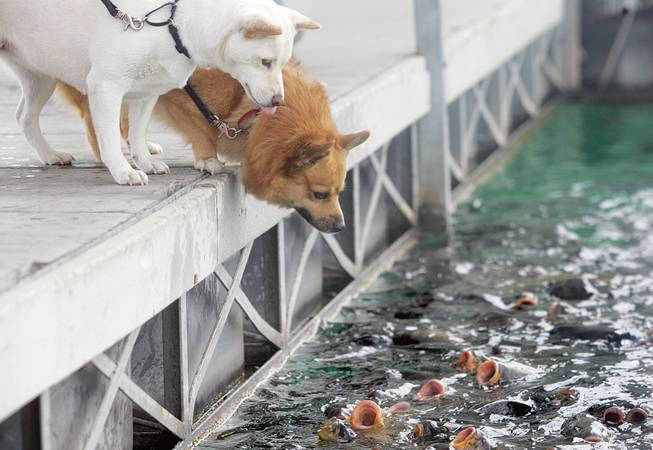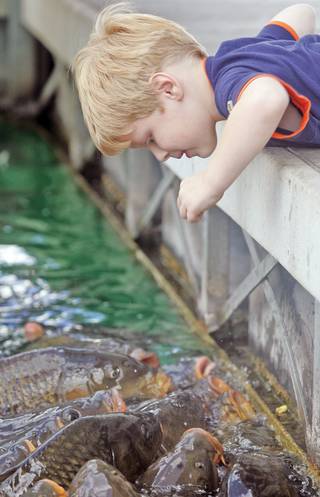
Monica Armstrong’s dogs Angel, left, and Corky stop to watch carp at the Las Vegas Boat Harbor.
Thursday, Oct. 2, 2008 | midnight
Carp are the swarming, splashing beggars of Hemenway Harbor.
The popcorn-gobbling pets who crowd around docks at Lake Mead Marina and Las Vegas Boat Harbor are a popular tourist staple, but they don't do much else for Lake Mead.
The overgrown gray goldfish have multiplied to an abundance since their introduction in the Colorado River more than 100 years ago — to the point that they now make up a large part of the lake's ecosystem, Jon Sjoberg, fisheries supervisor for the Nevada Department of Wildlife, said.
Though they're a prevalent force, they have little positive effect on the area, he said.
The state Fish Commission introduced the species in the 1880s for sport-fishing and eating, but tastes have changed and people just don't fish for them anymore.
"In a lot of places people came from to settle in the West, carp were a popular fish," he said. "People's perspectives change over time. A hundred years ago they probably ate a lot of things we wouldn't find appealing now."
Sjoberg himself has never tasted carp.
The dwindling culinary popularity left the carp population unchallenged for years, and it grew. The fish aren't just concentrated near the shore, but heavily dispersed in the lake. While they are a dominant fish, they no longer help the lake's ecosystem, Sjoberg said.
"They don't really fit in terms of contributing anything, or even being a significant part of the food chain as food for other fish," he said.
They get too big too fast, so stripers and bass can't eat them. Eighteen-inch carp aren't unusual.
Also, they stir up sediment, clouding the water.
Carp feed on vegetation at the bottom of the lake and destructively tear up vegetation in the water that acts as cover for other fish.
"I don't have any personal feelings one way or another, other than they're not really a very useful part of the system and potentially have downsides," he said.
Others, however, take joy in the hungry masses at the docks.
P.M. Thongchan Suwong, a Buddhist monk, for 10 years has traveled to Lake Mead monthly from his Las Vegas home to visit the carp.
On Sept. 24 at Lake Mead Marina, he tossed fistfuls of popcorn at a group of fish and said feeding them was good for his soul.
"Buddhists believe if you can give some charity, it's good for your life," Suwong said. "Fish don't have much of a chance to find food for themselves. It makes them happy."
Nearby, Bob and Sue Bixby, of Idaho, brought their 5-year-old granddaughter to feed the carp.
On his knees leaning into the water, Bob Bixby offered popcorn to the fish like he was offering hay to a horse.
"They'll eat out of your fingers!" he said.
Sabrina Marks, who for four years has worked at the marina's market, said adults and children buy $1.50 bags of popcorn for the fish all day long.
"They're amazed," she said. "People say they've never seen anything like it."
Cassie Tomlin can be reached at 948-2073 or [email protected].


Join the Discussion:
Check this out for a full explanation of our conversion to the LiveFyre commenting system and instructions on how to sign up for an account.
Full comments policy